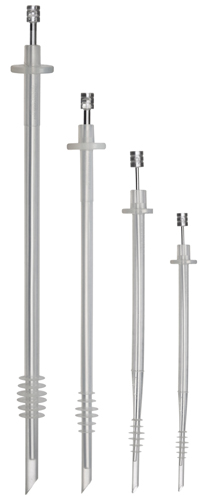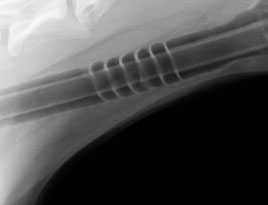Innovative Animal Products offers a comprehensive line of veterinary orthopedic supplies and devices related to External Fracture Fixation, Internal Fracture Fixation, and Joint Stabilization.
SAFE SEAL |
safe seal » surgical supplies » products » home |


The Next Generation in Endotracheal Tubes
SAFE: Baffles prevent over insufflation - no pressure points
EASY: Faster insertion and removal - less traning needed
ECONOMICAL: Only four sizes needed for dogs raning 10 - 200lbs
Innovative Animal Products (IAP) is proud to announce a revolutionary new concept in endotracheal tubes. IAP has launched SAFE-SEAL ENDO TUBE, clearly changing the scope of safety in surgical procedures. The SAFE-SEAL ENDO TUBE advanced technology will transform and modify the face of surgery and will dominate in safe surgical practices.
The new revolutionary SAFE – SEAL ENDO Tube utilizes a series of silicone baffles to replace the inflation cuff. It eliminates the risks of over inflation, under inflation and leaky tubes. The soft, flexible baffles seal the trachea without pressure and cleanses the trachea of all fluids upon extubation .
Only 4 sizes of tubes are necessary for dogs weighing 10 to 200 pounds. The ET tube’s one piece construction of medical grade silicone is autoclavable.
Safety, longevity and cost effectiveness place the SAFE-SEAL ENDO TUBE in a world apart from the others.
Advantages & Benefits
- Solid one piece construction of medical grade silicone.
- No moving parts to fail.
- Can be left in the same position in the trachea for extended periods of time
- The Y tube adapter fits snug but will not seize to the plastic of the Y tube.
- The tube will rotate in the trachea during surgery without injury.
- Transparent, so blood or fluids can be visualized in the tube.
- Autoclavable
 How does the Safe Seal Endo Tube work:
How does the Safe Seal Endo Tube work:
Almost all ET tubes used today depend upon an inflation cuff to seal the tube in the trachea, except the Safe-Seal™ ET tube featuring the Blaine Bafflex System. This new technology uses a series of 6 silicone baffles with carefully engineered pattern and spacing to seal the trachea without pressure points. The flexible baffles allow an “o-ring effect”. The Safe-Seal ET tube lies in the trachea and the sealing baffles touch the tracheal wall leaning towards the larynx. Thus, when the patient inspires the silicone baffles are sucked against the trachea forming a tight seal.
The special design allows passage of pressure exceeding 20-30 centimeters of water in the patient’s lungs. If the pop-off valve is accidentally left closed, the excess pressure is released and no harm will come to the patient. If more than 20-30 centimeters of water pressure is desired, the tube is merely withdrawn ½ inch causing the baffles to flip over and the tip will then face caudally thereby allowing as much pressure to be applied as deemed necessary.
These soft, flexible baffles are atraumatic to the tracheal surface due to the limited contact of the baffles. There is minimal contact with the tracheal wall when using the Safe-Seal tube as opposed to the large area of contact of inflation cuff tubes. This means the tube can be left in the same position for extended periods of time.
Another advantage is the “squeegee” effect when extubating, by scraping the trachea clean of any fluids present.
The Safe-Seal ET tube with the Blaine Bafflex System eliminates dangers of deflation or over inflation.
The standard tubes used today are constructed of rigid, curved plastic. This shape and rigidity forces the tip of the tube against the tracheal wall when inflated, causing a point of pressure. The Safe-Seal tube’s baffles keep the tip of the tube centered in the trachea. It is ultimately safer to use and can cause no damage to the trachea.
Frequently Asked Questions
1. What makes this endotracheal tube better?
The Safe-Seal tube was developed to eliminate the problems associated with inflation cuff tubes. No danger of leakage, over pressurization, under inflation or need for replacement make this tube safer and cost effective. It cleanses the trachea upon extubation and is atraumatic to the tracheal mucosa.
2. Do I need to worry about the tube kinking?
The soft, flexible nature of the tube is an extreme advantage. Rotation of the patient will not cause harm to the trachea because the baffles rotate easily. As with all tubes, a right angle bending force could cause kinking. The operator should be aware that the tube should be securely attached to the snout and if using a nonrebreather apparatus, that it should be kept in front of the patient on the table. Kinking has not been a problem in the seven year clinical trials. When using the smallest tube, the tip of the tube is ¼ inch and is therefore more flexible. The shaft of the tube is 3/8 inch diameter and resistant to kinking. As long as the flexible tip is safely inside the trachea, it is not subjected to bending forces.
3. What about sterilization and cleaning?
The medical grade silicone is autoclavable and resistant to cold disinfectants. Gas sterilization is safe but not necessary. The durable silicone can be scrubbed in the usual fashion.
4. What range of tubes do I need?
Only 4 sizes of tubes are necessary for a small animal practitioner for dogs weighing 10 to 200 pounds. This makes the Safe-Seal Endotracheal tube very cost effective.
5. Will water or fluids leak past the tube during procedures such as dentals?
No. The tube is designed to seal with 20-30 centimeters of water pressure in the trachea. Unless positive pressure exceeding this amount is applied in the pharynx, no passage of fluid is allowed to enter the lungs.
6. How does the tube prevent over pressurization of the lungs of my patient?
The carefully spaced and tapered baffles are designed to allow excess of 20-30 centimeters of water to bypass and escape. Thus, if the pop-off valve is accidentally left closed, the pressure will be released and no harm will come to the patient.
7. What about “dead air space’ in small, brachiocephalic breeds?
The tidal volume of a dog’s lungs determines if dead air space is a problem. A 20 pound pug with a short nose has roughly the same tidal volume as a 20 pound Whippet with a long nose. The length of the nose is irrelevant. Use of a non-rebreather for small dogs is useful whether using the Safe-Seal tube or the conventional inflation cuff tubes.
8. How do I determine the correct size of tube to use?
There is tremendous variation in the size of the trachea and larynx between different breeds of dogs. As a general guide line the small tube will properly fit dogs ranging from 10 to 30 pounds. The middle size tube will usually work in dogs from 25 and up to 80 pounds and the large tube will work well in dogs from 70 to 200 pounds. A simple rule of thumb is if the tube feels too tight or too loose upon insertion, use the next size tube, smaller or larger as appropriate.
9. Why do I hear air leakage sometimes when I first insert the Tube?
If a patient is “light” when first intubated, he may cough or forcefully expire. The baffles will release pressure exceeding 20-30 centimeters of water. So when first tubed, a “honking” sound of this pressure release is normal. When the patient is breathing normally, no leakage will occur. In either case, there will be no leakage during inspiration, so the patient will be receiving all the oxygen and anesthetic he requires.
10. What is the proper method of inserting the tube?
The stylet included with the tubes is necessary due to the flexibility of the tube. Insert the tube in the usual fashion and stop inserting while the tube is in a forward motion. This will insure the baffles will seal the trachea and allow excess pressure to escape. Remove the stylet and secure the tube to the snout in the usual ways.
11. Can positive pressure be applied?
Yes, 20-30 centimeters of pressure can be applied. If the operator desires more pressure, the tube is merely withdrawn ½ inch, and the baffles will flip over and as much pressure as deemed necessary is available.
12. Why does the Safe-Seal tube cause no threat of damage to the Trachea?
There is minimal contact with the tracheal mucosa with the Safe-Seal ET tube and the pressure caused by the bending of the baffles varies between 1-3 centimeter of water. Inflation cuff tubes have a large area of tracheal contact and require up to 30 centimeters of water pressure to seal. If inadvertent movement of the tube occurs, the tube will rotate and not cause friction damage to the mucosa. The baffles keep the tip of the ET tube centered in the trachea at all times, thus not allowing pressure points typical of inflation cuff tubes.
Testimonials
Amy Carr, D.V.M., DACVECC
Carlsbad, CA
My name is Amy Carr and I am a Diplomate of the American College of Veterinary and Critical Care, with over twenty year of experience in the field. Dr. Jerry Ratterree recently asked me if I would try his Safe~Seal Endotracheal tube and give him my comments on the experience.
I am happy to report the I used the unique endotracheal tube on several patients ranging in weight from 25 to 60 pounds and am now a fan of this tube. It is easy to place and I like the fact that it does not require a cuff, which can be improperly inflated to adverse effect. The design with baffles [Blains] appears to be atraumatic and we did not notice any complications such as coughing or gagging. One patient did vomit and aspirate during the course of a surgical procedure. When we removed the tube the ingesta was scraped up by the baffles [Blaines] and we did not see any evidence of subsequent aspiration pneumonia. I would be happy to replace my current endotracheal tubes with this tube.
I am not related to Dr. Ratteree and was not compensated for my participation in this study. Please contact me if I can be of further assistance.
Sincerely,
Amy Carr, D.V.M. DACVECC
Deborah Fox, D.V.M.
Riverside, CA
Recently we had anesthetized an older dog for a nasoscopy and cranial radiographs. After induction we intubated him with one of the new Safe Seal endotracheal tubes and put him on Isoflurane. During the procedure, we noticed a smell of anesthetic gas coming from his mouth and nose, but we assumed the tube was a little too small and, as he was stable and maintaining a good plane of anesthesia, finished the procedure as planned and the dog recovered uneventfully. While readying the machine for the next patient, the technician noticed that the pop-off valve on the anesthetic machine had been closed the ENTIRE time that this patient was under anesthesia. I believe that the design of the new Safe Seal tube allowed the increased pressure to safely vent past the baffles, prevented some serious complications, and possibly saved his life- with any other endotracheal tube he might have died.
Please feel free to contact me if you have any questions- I think these tubes are great!
Deborah Fox, DVM
Dennis Riggs, D.V.M.
Anaheim, CA
With reference to the [Safe~Seal] endotracheal tube developed by Dr. Ratterree, I found it very useful and experienced no problems.
I liked the wide weight range adaptability, function very well within the designed range for canines, 40-60 pounds.
I feel more confident in its seal since there is no air cuff that can leak. It worked as well, if not better, then the low pressure/inflation cuff tubes I am currently using. I liked the longer tube adapter on the end. It give more protection for the softer portion of the tube.
Overall, I'm impressed with the revolutionary design.
Dr. Dennis Riggs, D.V.M.





